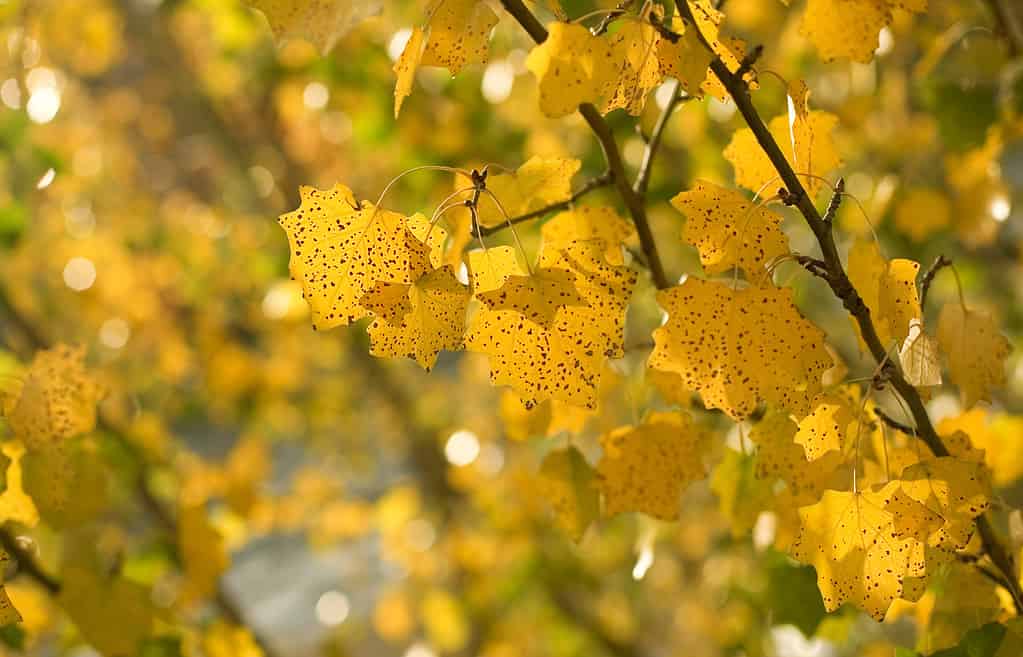You’d be forgiven if you believed all aspen trees were identical. However, there are actually five main types of Aspen trees. Each of these types has its own unique characteristics.
The term “aspen” is a common name for certain tree species. Most of these species are in the section Populus, but this isn’t always true, depending on the local customs.
Generally, all aspen trees live in colder regions with cool summers, particularly in the north of the northern hemisphere. They tend to like mountains and high plains and grow to around 50 to 100 feet tall. Due to these similarities, it’s easy for these trees to get mixed up with each other. They can look and grow very similarly.
Let’s look at all six types of Aspen trees:
1. Quaking Aspen (Populus tremuloides)

This aspen tree species is the most common one in North America in just about every part of the continent.
©krblokhin/iStock via Getty Images
The quaking aspen is the most widespread aspen in North America. Its bark is smooth and white, and its leaves turn brilliant gold in the fall. This particular aspen can grow up to 80 feet tall. You can identify it pretty easily in the fall, as its leaves are often very obviously yellow.
You’ll find this aspen in many habitats across North America, as it ranges from Alaska all the way to Mexico. It can be found at elevations up to 11,500 feet. It prefers well-drained soil, but it isn’t very picky about the temperature.
The largest organism on earth is a quaking aspen called the Pando aspen clone. This collective organism is 40,000 individual aspen trees that all have a collective root system, and it’s believed they were born from a single seed at the end of the last ice age.
2. Bigtooth Aspen (Populus grandidentata)

The easiest way to tell bigtooth aspen trees apart from
othersis its very coarsely toothed leaves, which is how the species got its name.
©Wolfdale64/iStock via Getty Images
The bigtooth aspen is native to eastern North America. You can identify it thanks to its very large and coarsely-toothed leaves, hence its name. It also has a pretty fast growth rate compared to other aspens, but it only reaches around 80 feet tall. That said, the largest one reached 130 feet tall.
This aspen prefers moist, well-draining soil, so it typically grows in floodplains and riverbanks. You’ll find it most often in hardwood forests.
This tree is an important food source for wildlife, including rabbits, deer, and even beaver. Sadly, it is also susceptible to some diseases more than other aspen varieties.
3. European Aspen (Populus tremula)

The European Aspen is found throughout much of Europe and some parts of western Asia. It’s very similar to the quaking aspen, otherwise.
©anutr tosirikul/iStock via Getty Images
As the name suggests, the European aspen is native to Europe and parts of Asia. It’s pretty similar to the quaking aspen despite growing on a completely different continent. It has slightly more oval-shaped leaves. It typically grows around 40 to 60 feet.
This tree is found in a variety of habitats. It can grow in forests, mountains, and on riverbanks. It prefers colder weather and well-drained soil, though.
This aspen was used in traditional medicine to treat pain and inflammation. Its leaves are also a vital food source for caterpillars of several different species.
4. Japanese Aspen (Populus sieboldii)

Like other aspen trees, Japanese aspens have yellow or orange foliage in the fall.
©Ekaterina Krasnikova/iStock via Getty Images
These trees are also named after their native area – Japan. They’re known for their big, glossy leaves that are very dark green in the winter and yellow in the fall. They’re much smaller than other aspens, too, only growing between 30 to 50 feet.
Like most aspen species, they prefer moist, well-draining soil. They’re most at home in colder regions and prefer mountainous terrain. However, they’re also popular ornamental trees, so you’ll commonly find them in gardens and parks.
This species is often grown as a bonsai tree due to its naturally smaller size and attractive leaves. Its bark was used in traditional medicine to treat various illnesses, too.
5. Chinese Aspen (Populus adenopoda)

Out of all the trees on this list, the Chinese aspen is the most threatened. Finding this tree in the wild is becoming harder and harder, though it can still be located in more remote, mountainous regions.
©cafetoday/iStock via Getty Images
The Chinese aspen is native to China, as you can probably guess. This species is less common than others on this list, and it can grow to a massive 80 feet. It has very large, heart-shaped leaves and smooth, white bark.
It’s most commonly found in the mountainous regions of China up to 10,000 feet. Like most aspen trees, it prefers moist, well-draining soil. They’re commonly used for lumber and fuel in their native area. However, they’re currently threatened by deforestation and habitat loss.
The photo featured at the top of this post is © lightphoto/iStock via Getty Images
Thank you for reading! Have some feedback for us? Contact the AZ Animals editorial team.






